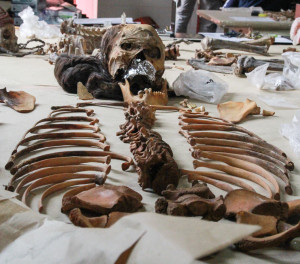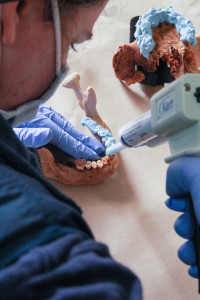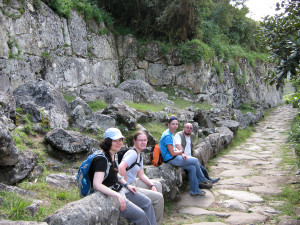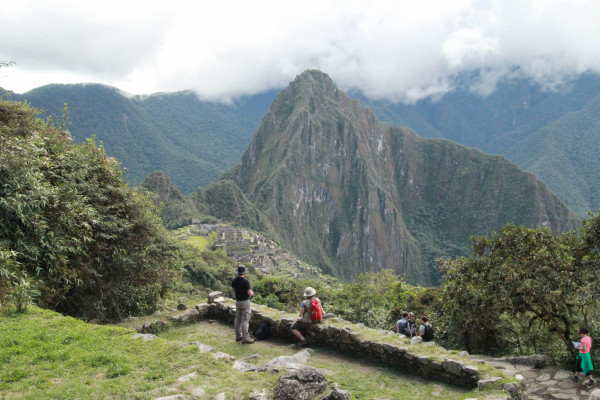By TAYLOR ROBINSON
Editor
Home to Machu Picchu, the Andes Mountains, and the history of the ancient Incan civilization, Peru is also home to the study abroad students of Washtenaw Community College for three weeks during the summer.
Gerald Baker, long-time WCC radiography instructor and 2006 retiree, first started taking students to Peru in 2000 after attending a conference where Arkansas State University was talking about the opportunity.
After receiving support from Larry Whitworth, WCC’s president at the time, Baker and his students worked with Dr. Sonia Guillen at Centro Mallqui, a research center in Peru where they preserve the remains of ancient cultures, including the Chinchorro and the Chiribaya.
 While WCC students spent time in the holes excavating mummies and treasures of aged cultures, Baker recalls students from other colleges including Yale, Stanford, and more, standing around in amazement that students from a community college were doing a lot of the work.
While WCC students spent time in the holes excavating mummies and treasures of aged cultures, Baker recalls students from other colleges including Yale, Stanford, and more, standing around in amazement that students from a community college were doing a lot of the work.
“In 2002, she (Guillen) decided that the only group she would accept anymore was from Washtenaw Community College,” Baker said. “And I think that it was because of the expertise of our students and how they got along well with the people in Peru.”
In 2007, Baker asked fellow radiography instructor Jim Skufis to join him. Skufis teaches International Studies and Radiography, as well as being the project leader for the class.
Although the students are learning forensic imaging which according to Skufis is “a whole up-and-coming discipline in the medical imaging field,” they are using a technique much different and much older while in Peru. Because of the lack of electricity for most of the day due to the desolate location, the students must use screen film radiography and a darkroom to generate the X-rays of the ancient cultures.
Katie Redfern, a 27-year-old WCC radiography graduate from Westland, traveled with the group to Peru this past trip, May 24 to June 15. She was able to apply what she learned in the classroom and attributes her skills to the instructors.
“I knew what I was doing there and it’s just because of what the teachers have done,” Redfern said. “They have been absolutely amazing.”
The study abroad opportunity is offered to radiography students who are in the last semester of obtaining their degree. Redfern graduated from WCC and finished her certification in basic imaging with a hands-on experience added to her resumé.
This is an experience that isn’t offered at any other community colleges in the United States according to the instructors involved. And in 2013, the offer was extended to WCC’s anthropology students in addition to radiography. Chris Barrett, a WCC anthropology instructor, can attest to the rareness of the opportunity being offered to the students.
“The idea of being able to get our students involved really appealed to me,” said Barrett who’s now been on the trip twice. “Getting students to do field work and collecting actual data and being able to do something with that data instead of waiting until they are at a four-year school or graduate school? I thought it was a great idea.”
 Although the students do get to enjoy the beautiful sights, they are doing a great amount of work for the Peruvian people. While the radiography students are busy taking X-rays of bones, the anthropology students are taking castings of teeth and ordering the bones of the human body.
Although the students do get to enjoy the beautiful sights, they are doing a great amount of work for the Peruvian people. While the radiography students are busy taking X-rays of bones, the anthropology students are taking castings of teeth and ordering the bones of the human body.
“It’s not a vacation. It is now somewhat morphed into a field study where you are learning not just about the culture but are learning how to do a specific skill set,” Skufis said. “That’s a three-week field study course. You don’t get anything this good at U-M or Eastern. This is something else. Honestly said, we are the only ones that do this.”
This was the second trip for 21-year-old anthropology student Elizabeth Jenkins from Canton. Not bothered by the amount of work, Jenkins claims that it was actually her favorite part.
“It’s the field I love, so actually being able to do the work without anybody necessarily telling me what to do too much, just sitting down and being confident in my decisions is something that is really an awesome feeling,” Jenkins said. For her, the second time around solidified her career choice.
“Being able to compare my experience and the amount of work I collected this time compared to last time was really a confidence booster and showed me that I still want to do this field,” Jenkins said.
If all goes well and there are enough interested students, the next trip to Peru will be a little different. Not only will the group be traveling to a new location, Leymebamba, but Baker has also decided after more than a dozen total trips and five times seeing Machu Picchu, this past time was also his last time.
“He’s left it in mine and Chris’s hands. It’s been great every year,” Skufis said. “We’ve never had a year where students come back and say ‘Well, that was really a drag. I wish I wouldn’t have done that.’ They come back and say, ‘This was the best experience of my life, it was far better than I ever thought it was going to be.”


